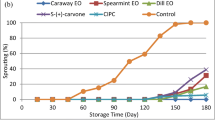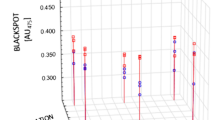Abstract
Russet Burbank and WC230-14 potato tubers were stored at 0 C (32 F) and 5 C (41 F) in air, air plus 4% CO2 and air plus 8% CO2 for a 175 day storage period. Four times during this period, tubers were removed and inoculated withErwinia carotovora var.atroseptica (van Hall) Dye orFusarium roseum var.sambucinum (L. K.) Sn. and H. and stored at 17 C (62.6 F). Tuber samples were also reconditioned for two weeks at 17C(62.6 F) and then inoculated. Tubers were evaluated for rate of membrane permeability, free glucose, free fructose, and sucrose content and the rate of tuber decay by the two pathogens. Relative to 5 C (41 F), 0 C (32 F) storage increased sugar content, membrane permeability and the rate of tuber breakdown. Increasing CO2 during storage at 0 C (32 F) and 5 C (41 F) increased each of the above parameters. Reconditioning tended to alleviate the adverse effects of 0 C (32 F) storage and increasing CO2 levels, but varietal differences existed. A significant and high correlation was obtained between the rate ofErwinia decay, membrane permeability, and sucrose content of the tubers.
Resumen
Tubérculos de papa de los cultivares Russet Burbank y WC230-14 fueron almacenados a 0 C (32 F) y 5 C (41 F) en aire, aire mas 4% CO2 y aire mas 8% CO2 por un periodo de almacenaje de 175 días. En cuatro oportunidades durante este periodo se sacaron tubérculos y se inocularon conErwinia carotovora var.atroseptica (van Hall) oFusarium roseum var.sambucinum (L.K.) Sn. & H. y luego se almacenaron a 17 C (62.6 F). Otras muestras de tubérculos fueron reacondicionadas durante dos semanas a 17 C (62.5 F) y luego inoculadas. La evaluatión de los tubérculos se hizo en base al grado de permeabilidad de las membranas, contenido de glucosa libre, fructosa libre y de sacarosa y el grado de descomposición de los tubérculos por los dos patógenos. En relación a 5 C el almacenamiento a 0 C aumentó el contenido de azúcares, la permeabilidad de las membranas y el grado de descomposición de los tubérculos. El aumento de CO2 durante el almacenamiento a 0 y 5 C aumentó los dos parámetras dados arriba. El reacondicionamiento tendió a aliviar el efecto adverso del almacenaje a 0 C y de los niveles crescientes de CO2 pero hubieron diferencias entre cultivares. Se obtuvo una alta y significativa correlatión entre el grado de descomposición porErwinia, permeabilidad de membranas y contenido de sacarosa en los tubérculos.
Similar content being viewed by others
Literature Cited
Aleck, J. R. 1973. The development of potato blackleg in relation to inoculum density and environment. Masters Thesis, Colo. State Univ., Fort Collins, Colorado 90 pages.
Craft, C. C. 1967. Respiration of potato tissue as influenced by previous storage temperature of the tubers. Am Potato J 44:174–181.
Johnson, G. C., C. Lambert, D. K. Johnson and S. G. Sunderwirth. 1964. Colorimetric determination of glucose, fructose, and sucrose in plant materials using a combination of enzymatic and chemical methods. J Agric Food Chem 12:216–219.
Lund, B. M. and J. C. Nicholls. 1970. Factors influencing soft-rotting of potato tubers by bacteria. Potato Res. 13:210–214.
Lund, B. M. and G. M. Wyatt. 1972. The effect of oxygen and carbon dioxide concentrations on bacterial soft rot of potatoes. I King Edward potatoes inoculated withErwinia carotovora var.atroseptica. Potato Res. 15:174–179.
Nielsen, L. W. and F. A. Todd. 1946. Bacterial soft rot of Irish potatoes as influenced by sublethal temperatures. Sugar and permeability changes in the tubers. Am Potato J 23:73–87.
Nielsen, L. W. 1964. Pathogenesis of three Erwinia species to potato tuber tissue in CO2-N atmosphere. Phytopathology. 54:902.
Pratt, H. K., M. Workman, F. W. Martin and J. M. Lyons. 1960. Simple method for continuous treatment of plant material with metered traces of ethylene or other gases. Plant Physiol 35:609–611.
Smith, Ora. and C. O. Davis. 1963. Controlled atmosphere storage of potatoes for shipping. Am Potato J 40:329–330.
Workman, M. and J. Twomey. 1969. The influence of storage atmosphere and temperature on the physiology and performance of ‘Russet Burbank’ seed potatoes. Proc Am Soc Hortic Sci 94:260–263.
Workman, M. and J. Twomey. 1970. The influence of storage on the physiology and productivity of Kennebec seed potatoes. Am Potato J 47:372–378.
Additional information
Former Graduate Research Assistant
Colorado State University Journal Article No. 2103. Research supported in part by a grant from the San Luis Valley potato growers. Data taken from an M.S. thesis submitted by E. Kerschner to the Colorado State University graduate school as a partial fulfillment of the requirements for the Master of Science degree.
Rights and permissions
About this article
Cite this article
Workman, M., Kerschner, E. & Harrison, M. The effect of storage factors on membrane permeability and sugar content of potatoes and decay byErwinia carotovora var.atroseptica andFusarium roseum var.Sambucinum . American Potato Journal 53, 191–204 (1976). https://doi.org/10.1007/BF02852490
Received:
Issue Date:
DOI: https://doi.org/10.1007/BF02852490




